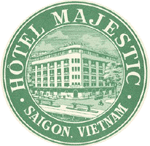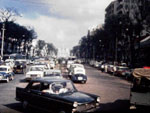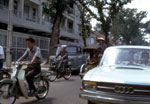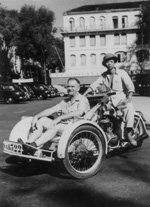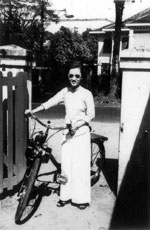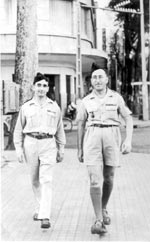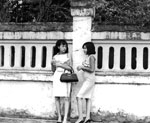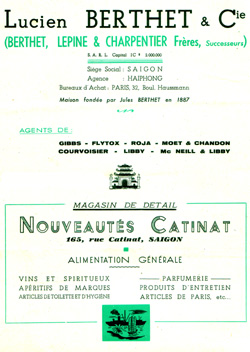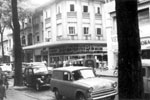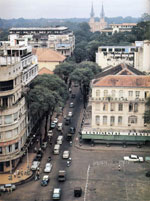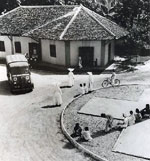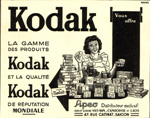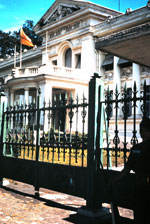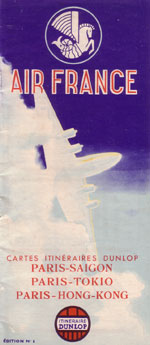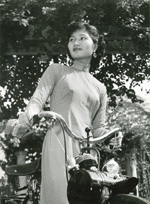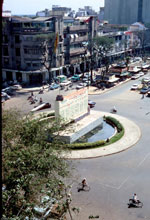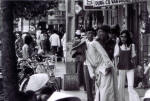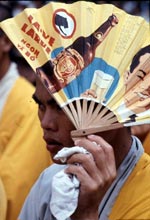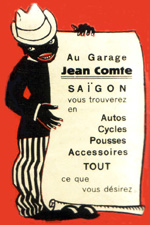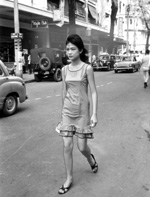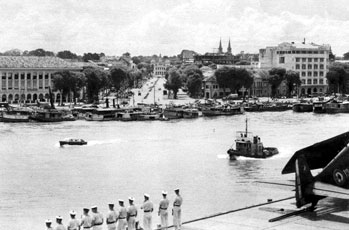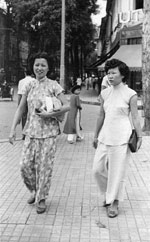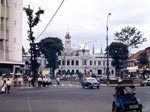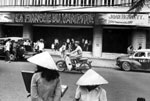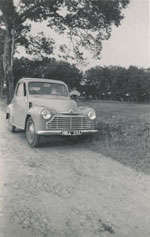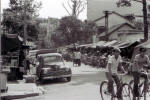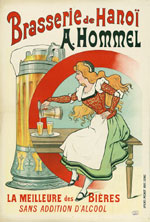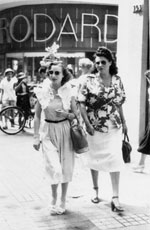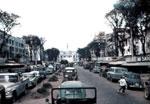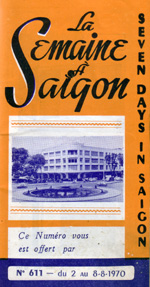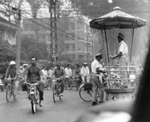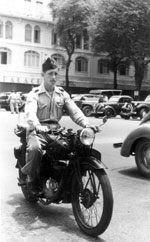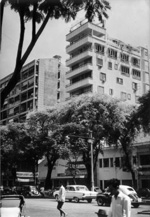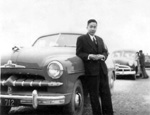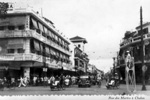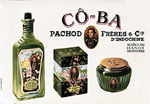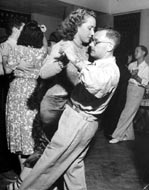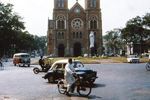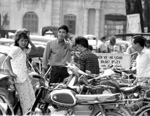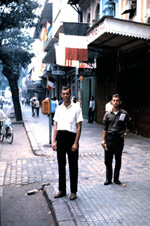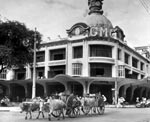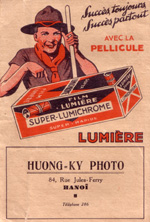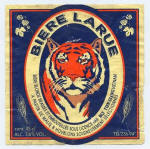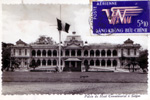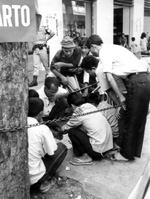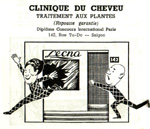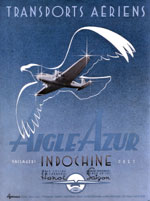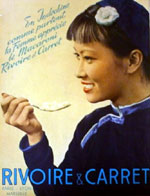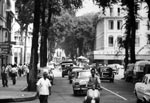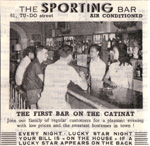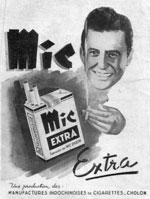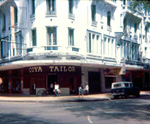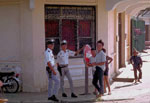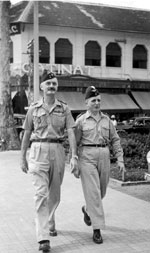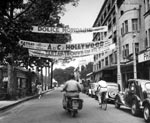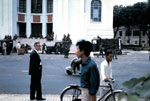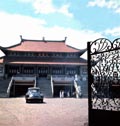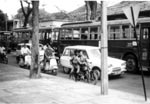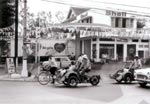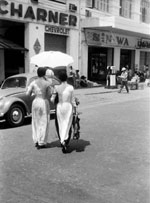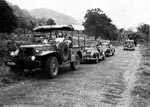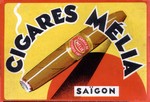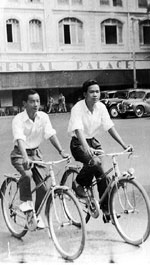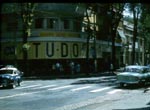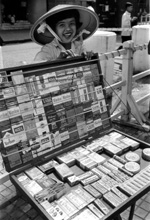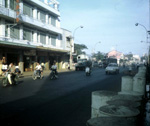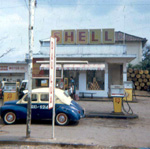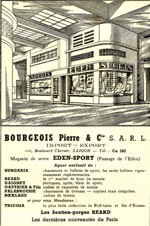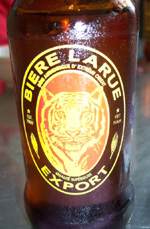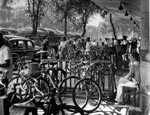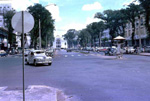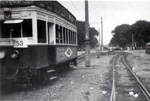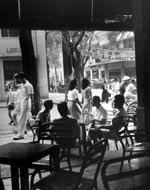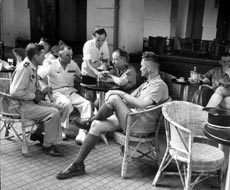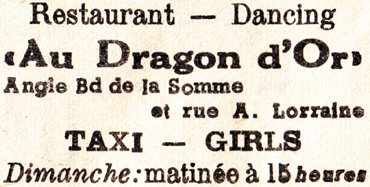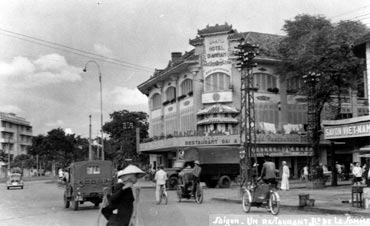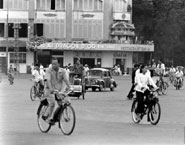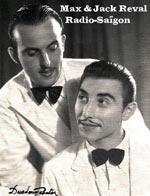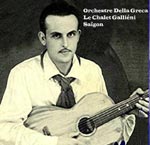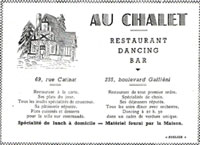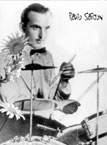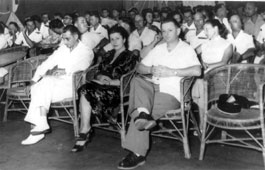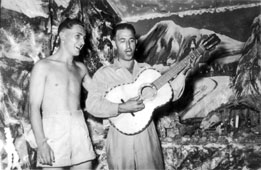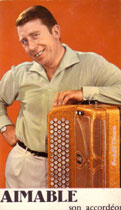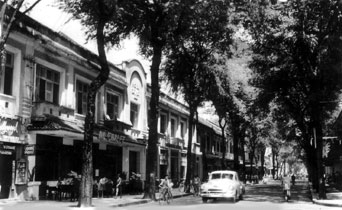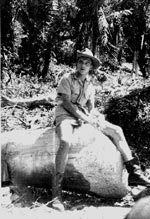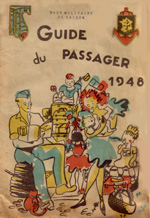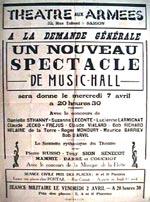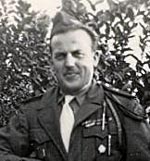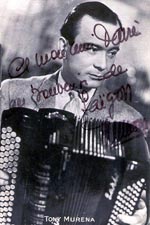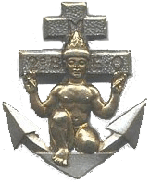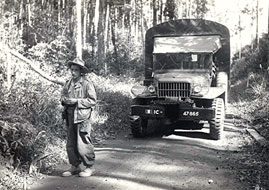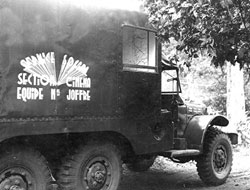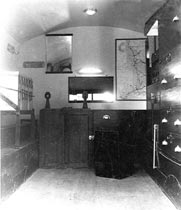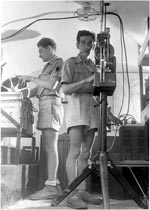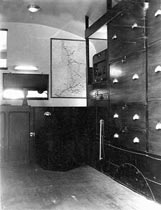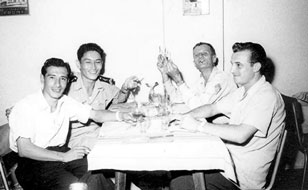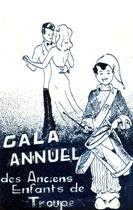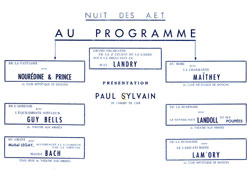
The cafes and dance halls of Saigon in 1948
The city center of Saigon remained attractive for the French army in Indochina with its numerous cafes and dance-halls, especially on Catinat Street and Charner Boulevard.
All these places were supposed to overcome the âcolonial boredomâ of the French who were established but also âprisonersâ in the capital city.
The list below is by no means all-inclusive.
| SAIGON'S BARS & DANCE-HALLS IN 1948 | |||||||||||||||||||||||||||||||||||||||||||||||||
|---|---|---|---|---|---|---|---|---|---|---|---|---|---|---|---|---|---|---|---|---|---|---|---|---|---|---|---|---|---|---|---|---|---|---|---|---|---|---|---|---|---|---|---|---|---|---|---|---|---|
| Bars : | Dance-Halls | ||||||||||||||||||||||||||||||||||||||||||||||||
| Croix du Sud (The Southern Cross), Catinat Street | Le Chalet, GalliÃĐni Boulevard | ||||||||||||||||||||||||||||||||||||||||||||||||
| Le Continental, Catinat Street | Kim-Son, GalliÃĐni Boulevard | ||||||||||||||||||||||||||||||||||||||||||||||||
| La Pagode, Espagne (Spain) Street | Van Canh, GalliÃĐni Boulevard | ||||||||||||||||||||||||||||||||||||||||||||||||
| Pointe des Blagueurs (The "Joker's Point"), Belgium Embankment | Dragon d'Or, Somme Boulevard | ||||||||||||||||||||||||||||||||||||||||||||||||
| Bristol, Charner Boulevard | La Venise, Rigaud-de-Genouilly Square | Club, boulevard Charner | Tabarin, Bourdais Street | ||||||||||||||||||||||||||||||||||||||||||||||
| Aterbia, Charner Boulevard | Chez Joseph, Jean Eudel Street | ||||||||||||||||||||||||||||||||||||||||||||||||
| Bodega, Espagne (Spain) Street | Au Vieux Cambodge, Jean Eudel Street | ||||||||||||||||||||||||||||||||||||||||||||||||
| Theatre Cafe, Theatre Square | Le Lion d'or, Albert 1er Boulevard | ||||||||||||||||||||||||||||||||||||||||||||||||

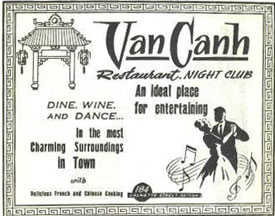
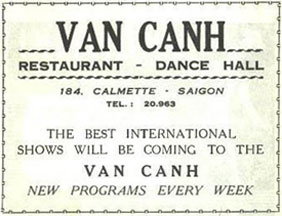
"Au Dragon d'Or" Dance Hall (Kim Long)
Dragon d'or Dance Hall and Dai-a Restaurant were located at 181 Somme Boulevard in Saigon.
Radio Saigon
Richaud Street
Max & Jack Reval
With Jack Reval (real name Jacques Lavier), there were two of us from the Sologne region of France, he from Marcilly-en-Villette and me from Romorantin), and we were on Radio Saigon once or twice a week to tell stories about people from Sologne which somewhat boosted the morale of the troops in the vicinity of Saigon, and all those who could receive us.
We also appeared in different clubs in town, particularly Catinat Street, Saigonâs main street, which was at our own risk given the permanent guerilla war in progress.
Indeed, the merchants of the city who had not signed up for the continued ÂŦ protection services Âŧ of the Vietminh armies could expect severe reprisals in the form of grenade-throwing or Molotov cocktails.
It was thus that my colleague Mammie, an Antillean guitarist, and I, a drummer, saw several grenades roll past us on the dance floorâĶ Luckily, my guitaristâs back was so wide that I was able to hide behind him without risk, while my poor Mammie was hit by numerous pieces of shrapnel. On the dance floor, several Vietnamese couples lost their lives. I sometimes stood in for a member of an Argentinean orchestra for a few weeks in the biggest club in Saigon, âThe Chaletâ, located on the Cholon Road, and run by a Frenchman.
Au Chalet
255 GalliÃĐni Boulevard
The Argentinean orchestra, "Della Greca"
In this photo of Max, he is indeed the drummer in the Della Greca orchestra, and the guitar in his hands is that of the orchestraâs guitarist. This was the guitarist who accompanied Tino Rossi in all his films of the era, ÂŦ Far from the Guitars Âŧ, ÂŦ Naples in the Kiss of Fire Âŧ, etc
This select night club catered only to the upper crust of Saigon and Cholon, from superior officers of the French army to the big Chinese merchants from CholonâĶ, and, by chance, in this place and despite the explosive situation, the danger was barely noticeable, as the Vietminh army no doubt received a tangible measure of assistance from the citizens of this mostly Chinese city.
Au Chalet
69 Catinat Street
Aimable
It should be noted that âThe Chaletâ in Cholon also had another branch, âThe Catinat Chaletâ. The Catinat Chalet was located at 69 on Catinat Street, which was a cabaret where the late and well-known accordionist âAimableâ would appear, and with whom I had the pleasure of playing several times.
Besides our practice sessions, we also appeared on Radio Saigon with my friend Jacques Lavier, a.k.a. âJak Reval Âŧ, in a comic duo spoken in our Sologne dialect, as he was from Marcilly-en Villette, and I was from Romorantin. This display of jokes, funny stories, and derision was intended to relax the troops. When the new Governor-General of Indochina, Pignon, was invited by Norodom Shianouk, King of Cambodia, the Armed Services Theater Orchestra was pressed into service to play for the week-long festivities at the Royal Palace in Phnom Penh. Finally, in mid-1948, the situation in Saigon became critical and, for lack of reinforcements certain services, among them the Armed Services Theater, were disbanded, their members having been sent to combat units.
For me, it was temporary; first the Armed Services Cinema, and then the Commando unit of the 2nd B.M.E.O. (Bataillon de Marche dâExtrÊme-Orient = Far-East Marching Batallion), in the Mekong Delta and for Lavier, North Indochina. I never heard from him again.
it pleases me to bring the Armed Services Theater back to life a bit, having noticed that nothing about it still exists, even in the current archives of the French Army.
This theater group, which in its day had its purpose, would have been forgotten like many other things in that dirty war in IndochinaâĶ..

|
Christmas, 1946
Jacques Caron is from Noyon, in the Oise (department in France). He is the son of a city employee who handled ration coupons and joined the resistance very early on. He is himself a liaison agent and assists his father in the production of false papers by developing photos in his small clandestine darkroom. In 1944 at age 18, he joins up for the duration of the war. After the liberation of France, he leaves for Indochina. Upon joining our battalion, the captain had us write a paper. He was quite astonished to read in mine that I left my native Picardy without regret, having decided to pull my weight. I acquired a reputation of being a serious type which earned me the assignment of whorehouse guard during our four-month wait in Marseilles!
|
The Army Theater By Henri DarrÃĐ, then corporal and movie projectionist.
Artists, actors, singers, comedians, illusionists, musiciansâĶ in 1947 there was a group of about 50 of us, men and women, in this theater at: Tony MurÃĐna My godfather Tony MurÃĐna (published by LÃĐon Agel â Paris) had come to Radio Saigon at the end of 1947. Christmas 1948 In 1947, after general Leclerc had left, the shantytowns returned and with them attacks on servicemen. Every night we were lulled by the sharp sound of jungle drums, apparently played for death vigils.
Each of us is thinking that tonight is Christmas Eve in France. For us it will remain routine, dust, mosquitoesâĶ For the most part this Christmas Eve will be observed in the outposts where nothing special is planned: Saigon is under siege. |

The motion picture service in Indochina
by Henri DarrÃĐ
- in the left picture, Hugues JuÃĐ in front of the tool of his trade â a Dodge 6X6 (Marshal Joffre)
- in the picture on the right, the social services truck (Motion Picture Group) of Marshal Joffreâs team.
Rediscoveries with the Cinema of Indochina...
Thanks to the sites which publish my accounts on the internet I was contacted a few days ago by Daniel JuÃĐ, a veteran of the Indochina Air Force, who served as a Master Medic at the base at Gia Lam (Tonkin) from 1952 to 1954.
This veteran of Indochina had noticed, while reading one of my stories, that I too, had served with the army motion pictures section in Saigon, where his brother, Hugues JuÃĐ (deceased in 1995), had served in the same unit during the same years â 1952/54.
I was later assigned, along with my two teammates, to the GMC âMarshal Bazaineâ, in which our mission took us to outposts more isolated and farther from Saigon, towards the Plain of Reeds and the Mekong Delta.
- In the left photo, the interior of the âMarshal Joffreâ truckâĶ everything was well secured to stand up to the rutted trails.
At the back the driverâs cab where the projectionists combined their job with those of driver, repairman, and sometimes even combatantâĶ
- In the center photo, the interior of the âMarshal Joffreâ truck and Hugues JuÃĐ busy with his Debrie 16 mm projector.
- In the photo on the right, at the back, one can see the map which was in all the movie trucks, and which showed the outposts to visit during a three-week tour.
Hugues JuÃĐ probably experienced the same fears, emotions and satisfaction that I had felt as well during our missions to these isolated outposts and in his memory as well as for his family I stand by anyone who, like myself and so many others, contributed to making life a little less somber for those who fought, far from their family, in this distant land of Indochina.

Camp Petrusky in 1954
Hugues JuÃĐ, far left in the photo, next to his brother Daniel, during their encounter at Camp Petrusky in 1954.

Annual Gala of November 6, 1954
of the Former Children of the Military (A.E.T.)
A word from the President:
Dear Friends,
The President welcomes you and invites you to enjoy the eveningâs entertainment.
The Night of the Former Chldren of the Military
With the big band of the 2nd Guard Legion under the direction of:
Jean-Landry
Presentation by
Paul Sylvain of the Air Force
With favors...and the amateur half-hour...
Bill of fare in Piastres:
Champagnes : Mumm Cordon Rouge ou Vert 290$, Pommery 1947 290$, Taittinger, Mercier 240$.
White wines: Tramminer, Riesling, Saint-Croix du Mont 90$.
Fine RosÃĐ wine: Arbois 90$.
Beers: French, German 30$.
Sodas: Piper Get soda, 1/4 Perrier, 1/4 Vittelloise, Grapefruit drink 25$, Soda 25$.
Cold Buffet:Cakes 10$, Cold cuts 30$, Sandwich 20$.
Cigarettes : American 25$, Bastos, MÃĐlia 5$, MÃĐlia Rouge 12, Golden Club 12$.
For payment, DEMAND A TICKET

